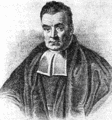Template:Selected anniversaries/April 7: Difference between revisions
No edit summary |
No edit summary |
||
| Line 12: | Line 12: | ||
||1805 – Lewis and Clark Expedition: The Corps of Discovery breaks camp among the Mandan tribe and resumes its journey West along the Missouri River. | ||1805 – Lewis and Clark Expedition: The Corps of Discovery breaks camp among the Mandan tribe and resumes its journey West along the Missouri River. | ||
File:Hasan Tahsini.jpg|link=Hasan Tahsini (nonfiction)|1811: Astronomer, mathematician, and philosopher [[Hasan Tahsini (nonfiction)|Hasan Tahsini]] born. He will become one of the most prominent scholars of the Ottoman Empire of the 19th century. | |||
||1823 – Jacques Charles, French physicist and mathematician (b. 1746) | ||1823 – Jacques Charles, French physicist and mathematician (b. 1746) | ||
Revision as of 15:23, 6 April 2018
1761: Mathematician, philosopher, and minister Thomas Bayes dies. He is remembered for having formulated a specific case of the theorem that bears his name: Bayes' theorem.
1789: Mathematician and physicist Joseph Fourier uses early version of Fourier series analysis to detect and prevent crimes against mathematical constants.
1811: Astronomer, mathematician, and philosopher Hasan Tahsini born. He will become one of the most prominent scholars of the Ottoman Empire of the 19th century.
1860: Physicist and crime-fighter Ernst Ruhmer invents a camera which uses the light-sensitivity properties of selenium to record images from past and future events. This type of camera is popular with math photographers, notably Cantor Parabola.
1867: Gem detective Niles Cartouchian works with Hasan Tahsini to recover stolen shipment of time crystals (nonfiction).
1889: Mathematician Paul David Gustav du Bois-Reymond dies. He worked on the theory of functions and in mathematical physics.
1899: Physicist and academic Petrus Leonardus Rijke dies. He explored the physics of electricity, and is known for the Rijke tube (which turns heat into sound, by creating a self-amplifying standing wave).
1995: Math photographer Cantor Parabola takes a series of photographs which capture temporal superimpositions from physicist and academic Petrus Leonardus Rijke in the form of a self-amplifying standing wave.






